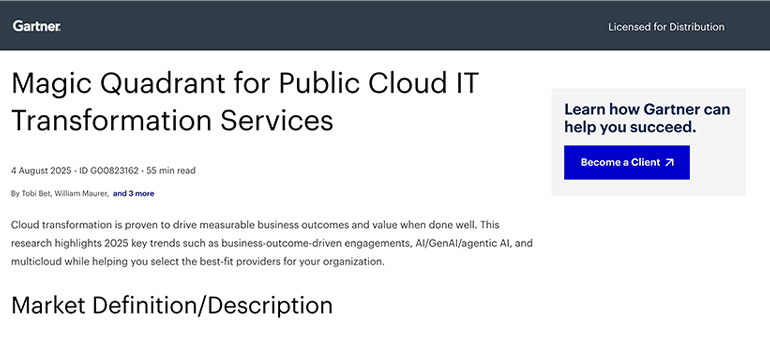Article VMworld 2019 update for Service Providers

By Insight UK / 14 Nov 2019 / Topics: Cloud
“VMware’s vision remains the same – enabling our customers to operate any application, on any device, from any cloud. With cloud as the foundation, we’re transforming the app experience and providing intrinsic security for your data,” said VMware’s CEO Pat Gelsinger. “We are redefining what’s possible.”
VMworld 2019 in Barcelona was an exciting, very well-organised week. Full of important news, exciting updates, previews and releases on industry hot topics which VMware shared with the rest of the IT world. This update provides a brief summary of the latest updates for service providers on topics such as multi-cloud management, security, containers and more.
Kubernetes and Containers as a Service
Kubernetes was definitely one of the major keywords of VMworld 2019. Although Kubernetes originated as a developer platform for building, deploying and running modern applications rapidly and efficiently, service providers must control and manage the applications and services in the right way. VMware has appreciated this and announced the roadmap for Containers as a Service solution, using CSE Container Service Extension and vCloud Director extension.
CSE allows Cloud service providers to create customized VM templates (Kubernetes templates) and enable tenant users to deploy fully functional Kubernetes clusters as self-contained vApps. Using CSE as a control plane facilitates the deployment of everything from the feature-rich Enterprise PKS, to CSE standard to Project Pacific. Project Pacific (another announcement from VMworld, see later on in this article) is a technology preview, which empowers IT Operators and Developers to accelerate innovation by converging containers and VMs into VMware’s vSphere platform with native Kubernetes.
Workspace ONE
VMworld 2019 also had some interesting announcements about the digital workspace. One was around Workspace ONE, VMware’s intelligence-driven digital workspace platform, which creates engaging employees experiences from onboarding to offboarding. A crucial factor in employee engagement, competitive advantage and business growth.
Last year at VMworld, the Intelligent Hub was announced to offer employees an app-store-like experience for delivering apps and modern services, such as notifications and people search. Mobile flows were also announced to provide 1-click actionable workflows, for example to approve a day off. This year, the self-service virtual assistant was announced that is powered by IBM Watson AI. Employees can easily complete IT and HR related tasks by asking questions via text or voice and receiving guided answers. Workspace ONE is the first digital workspace platform to integrate an artificial intelligence (AI)-powered virtual assistant.
VMware also works with HID Global, the leader in physical access control systems. This partnership allows employees to use the Intelligent Hub app on their personal or company-owned mobile device to gain entry to buildings using their company or personal owned phones.
Cloud cost management, security and governance via CloudHealth
VMworld brought about the introduction of CloudHealth Hybrid. GA at the end of Q3, CloudHealth Hybrid brings together the functionality of CloudHealth Data Center and the functionality of VMware vRealize Business for Cloud (vRBC) and Cost Insight into a single standalone SaaS offering. CloudHealth Hybrid offers a single platform with visibility into cost, usage, and performance of all hybrid cloud resources. With CloudHealth, organizations can quickly identify optimization opportunities, align costs and usage by business unit for showback, and plan successful migrations.
Taking cloud cost usage as an example, CloudHealth is all about workload optimization in a multicloud environment. It costs only a small percentage of the overall cloud expenditure and delivers considerable cost saving, averaging 30-40%, depending on the efficiency an organization already achieves. Its key aspect is that the software extracts information from the admin account about what workloads are being deployed, how they are performing and what recommendations can be made by shifting workloads, while maintaining the same performance. Cloudhealth is now available through VCPP MSP.
Carbon Black essential part of an intrinsic security vision
In the fight against cyber hackers and attackers, VMware announced the acquisition of Carbon Black, a new cloud security portfolio that is now available for service providers. Carbon Black characterizes VMware’s vision of intrinsic security by deploying more automation and eliminating risks for critical applications and sensitive data across clouds, data centers, end users, and the enterprise edge. Carbon Black will offer service providers the extra security features that they have to offer their customers. Carbon Black and AppDefence, will be available as an MSP offering for service providers.
Click-to-deploy applications packages with Bitnami
Another interesting upcoming acquisition is Bitnami, a “leader in providing validated and highly secure click-to-deploy applications and development stacks for major cloud and Kubernetes environments.” With Bitnami, service providers will have a platform to easily deploy and offer maintenance services to their customers.
VMware Cloud now available on Dell EMC
The announcement of the availability of VMware Cloud on Dell EMC is a huge step forward for edge and on-premise datacenter deployment by service providers. VMware Cloud is now pre-installed on Dell EMC’s server platforms as a pre-deployed solution. Service providers no longer have to build it, but can easily deploy it as a simple, secure and scalable IaaS solution for their customers, combining public cloud benefits with on on-premise infrastructure. Datacenter as a Service, delivered by Dell.
Containerization, security and NSX-T
NSX-T Data Centre, version 2.5 was previously unveiled at VMworld US, but Barcelona gave us Europeans the chance to take a look under the hood of some of the latest feature release. We know with NSX-T security has been decoupled from the hypervisor, which is a crucial to support cloud-native applications, bare metal workloads, multi-hypervisor environments, public clouds, and multiple clouds. Some of the new features to 2.5 include NSX Intelligence, a distributed analytics engine that provides continuous datacenter-wide visibility for network and application security teams helping deliver a more granular and dynamic security posture, simplify compliance analysis, and streamline security operations. NSX Intelligence is the crown jewel of the NSX-T 2.5 announcements. Other changes include the following:
With NSX-T 2.5, VMware is building upon the success of NSX Cloud and introducing a new Deploy and Operation mode referred to as the Native Cloud Enforced mode. This mode provides a consistent policy model across the hybrid cloud network and reduces overhead by eliminating the need to install NSX tools in workload VMs in the public cloud.
Distributed Intrusion Detection and Prevention (IDS/IPS) will be added to the NSX service-defined firewall offering rich capabilities to protect applications on east-west network traffic across private and public clouds. This this can be a big benefit for service providers in their ambition to offer new services.
Project Pacific: rearchitecting vSphere with Kubernetes
One of the sessions was devoted to Project Pacific, which is the biggest evolution of VSphere in a decade, according to VMware. Project Pacific is “rearchitecting vSphere to deeply integrate and embed Kubernetes for all modern apps on single platform.” Service providers can be at the cutting edge of technology if they can deliver Containers as a Service with Kubernetes through Project Pacific.
New Partner Programme as of 2020
VMware also announced the launch of a new partner programme from the beginning of 2020 under the name Partner Connect. Partner Connect is the new way in which VMware will work with and for partners offering modern choices, flexibility and innovations in the way business is done today. VCPP is an example of a current programme that is being transferred to Partner Connect. More information will follow soon. The billing for VCPP will not change.
Multitenancy with VMware Cloud on AWS
VMware will soon allow for multitenancy with VMware Cloud on AWS with VMware vCloud Director services. This multitenancy IaaS solution is a real game changer as Service Providers can leverage and serve bite-sized pools of VMware Cloud on AWS resources for small and medium-sized customers. Cloud providers can also use the global scale of VMware Cloud on AWS availability zones to seamlessly expand their cloud footprint to new regions, customers, verticals, and lines of business.
“For the first time, VMware Cloud on AWS will support multitenancy through the new VMware Cloud Director service, enabling MSPs to more quickly and easily create full software defined data centers in the AWS cloud for small- and medium-sized enterprises,” said Rajeev Bhardwaj, vice president of products, Cloud Provider Software Business Unit, VMware. “Partners will be able to accelerate their delivery of both VMware-based and native public cloud services, to more efficiently support customer operations across clouds, and better meet customer needs by deploying applications to whichever cloud best suits their business or IT requirements.”
Project Path
At VMworld 2019 Project Path was launched. Project Path is a unified, developer-ready platform, that offers cloud providers and managed service providers the opportunity to expand their cloud provider platform to a true hybrid and multicloud experience. This includes both on-premise clouds and hyperscalers like AWS, Azure, google cloud, Oracle cloud, and IBM cloud. Service providers are enabled to broker self-service multitenant environments in which they can deliver a wealth of products and services, including IaaS, containers, migration, back-ups, disaster recovery, object storage, Database as a Service, security and many more. Project Path will also help service providers support and management as customer management, usage, billing, reporting and customers. The central idea is that Project Path will help service providers to expand from infrastructure services to turnkey, developer-friendly cloud platforms.



